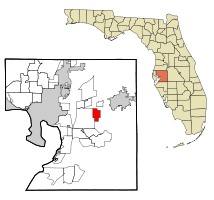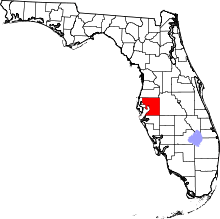Valrico, Florida
| Valrico, Florida | |
|---|---|
| CDP | |
 Location in Hillsborough County and the state of Florida | |
| Coordinates: 27°56′27″N 82°14′33″W / 27.94083°N 82.24250°WCoordinates: 27°56′27″N 82°14′33″W / 27.94083°N 82.24250°W | |
| Country | United States |
| State | Florida |
| County | Hillsborough |
| Area | |
| • Total | 5.7 sq mi (22.07 km2) |
| • Land | 5.6 sq mi (15 km2) |
| • Water | 0.1 sq mi (0.2 km2) |
| Elevation | 56 ft (17 m) |
| Population (2010) | |
| • Total | 35,545 |
| • Density | 6,347.3/sq mi (2,450.7/km2) |
| Time zone | Eastern (EST) (UTC-5) |
| • Summer (DST) | EDT (UTC-4) |
| ZIP codes | 33594-33596 |
| Area code(s) | 813 |
| FIPS code | 12-73700[1] |
| GNIS feature ID | 0292725[2] |
Valrico is a census-designated place (CDP) in Hillsborough County, Florida, United States. The population was 35,545 at the 2010 census.[3]
History
Valrico began as a region of cotton plantations known as Long Pond. It was renamed to Valrico, meaning "rich valley" in Spanish, in the 1880's when a philosophy professor from Tufts college, William G. Tousey, purchased property in the area. In 1890, an influx of new immigrants arrived following the construction of the Florida Central and Peninsular Railroads through the area.
When the railroad was completed, Tousey began building up the community with retail stores, streets, and a bank. In 1895, a major freeze halted these developments, and the population began to dwindle. Nonetheless, the town continued to press on, with a schoolhouse being completed in 1896. The population continued to fall drastically, from 100 people in 1893 to only 50 in 1911.
This setback did not deter local landowners from pushing forward with the town's development. Between 1910-1914 Judge Hamner, Governor Van Sant, D. Humbird, W.H., S.C. Phipps and W.F. Miller started an improvement project along Hopewell Rd, later designated SR 60. W.F. Miller, serving as president of the Valrico Improvement Association, raised $3500 to erect the Valrico Civic Center, now known as the James McCabe Theatre. The area's first general store was opened by Lovett Brandon in 1912.
Valrico once again suffered a major blow during the stock market crash of 1929, which saw nearly every business in the town shut down. Not until the mid-1950's did the town begin to see growth again, primarily due to the connection of SR 60 to Tampa's Adamo Dr, placing Valrico right along a major Florida thoroughfare.
- cyclist in Valrico
Geography
Valrico is located at 27°56′27″N 82°14′33″W / 27.94083°N 82.24250°W (27.940774, -82.242551).[4]
According to the United States Census Bureau, the community has a total area of 5.7 square miles (15 km2), of which 5.6 square miles (15 km2) is land and 0.1 square miles (0.26 km2) (1.41%) is water.
Demographics
| Historical population | |||
|---|---|---|---|
| Census | Pop. | %± | |
| 2000 | 6,582 | — | |
| 2010 | 35,545 | 440.0% | |
| source:[5] | |||
As of the census[1] of 2000, there were 6,582 people, 2,632 households, and 1,826 families residing in the community. The population density was 1,176.9 people per square mile (454.6/km²). There were 2,831 housing units at an average density of 506.2/sq mi (195.5/km²). The racial makeup of the community was 89.32% White, 3.21% African American, 0.49% Native American, 1.47% Asian, 3.57% from other races, and 1.94% from two or more races. Hispanic or Latino of any race were 12.82% of the population.
There were 2,632 households out of which 29.4% had children under the age of 18 living with them, 57.0% were married couples living together, 8.4% had a female householder with no husband present, and 30.6% were non-families. 25.8% of all households were made up of individuals and 14.4% had someone living alone who was 65 years of age or older. The average household size was 2.49 and the average family size was 2.99.
In the community, the population was spread out with 24.2% under the age of 18, 6.5% from 18 to 24, 29.1% from 25 to 44, 22.5% from 45 to 64, and 17.7% who were 65 years of age or older. The median age was 39 years. For every 100 females there were 95.0 males. For every 100 females age 18 and over, there were 93.1 males.
The median income for a household in the community was $98,700 and the median income for a family was $105,475. About 3.8% of families and 7.5% of the population were below the poverty line, including 7.3% of those under age 18 and 8.4% of those age 65 or over.
Education
Public high schools
Middle schools
- Barrington Middle School (public)
- Bell Shoals Baptist Academy (private)
- Foundation Christian Academy (private)
- Grace Christian School (private)
- Mulrennan Middle School (public)
- Randall Middle School (public)
Elementary schools
- Alafia Elementary School (public)
- Bell Shoals Baptist Academy (private)
- Buckhorn (public)
- Cimino Elementary School (public)
- Foundation Christian Academy (private)
- Grace Christian School (private)
- Lithia Springs Elementary (public)
- Nelson Elementary (public)
- Valrico elementary (public)
Private schools
- Bell Shoals Baptist Academy PK-8
- F.I.S.H.(Home Schoolers)
- Foundation Christian Academy PK-12
- Grace Christian School K-12
- Interactive Education Academy K-12
- Trinity Christian Academy 2-12
References
- 1 2 "American FactFinder". United States Census Bureau. Retrieved 2008-01-31.
- ↑ "US Board on Geographic Names". United States Geological Survey. 2007-10-25. Retrieved 2008-01-31.
- ↑ Florida Trend Report 2: State and Complete Places (Sub-state 2010 Census Data). Missouri Census Data Center. Accessed 2011-04-07.
- ↑ "US Gazetteer files: 2010, 2000, and 1990". United States Census Bureau. 2011-02-12. Retrieved 2011-04-23.
- ↑ "CENSUS OF POPULATION AND HOUSING (1790-2000)". U.S. Census Bureau. Retrieved 2010-07-17.
